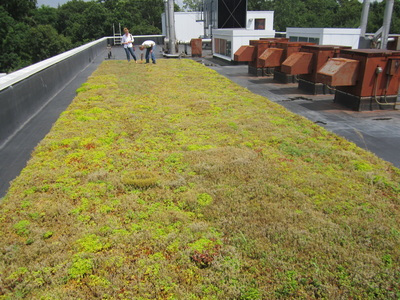Green Roofs
Green Roofs are one type of Green Infrastructure built with the goal of capturing excess water and heat as well as provide an area with the many green space benefits.
Benefits of Green Roofs
Conserve Energy
- The insulation offered by green roofs can reduce the amount of energy needed to moderate the temperature of a building. Roofs are the site of the greatest heat loss in the winter as well as hold the hottest temperatures in the summer. Green roofs cool the surrounding air during the summer through the process of evapotranspiration by plants.
Extends the life of your roof
- The presence of a green roof decreases the exposure of waterproofing membranes to large temperature fluctuations, that can cause micro-tearing, and ultraviolet radiation. Green roofs have a much lower burning heat load (the heat generated when a substance burns) than do conventional roofs (Köehler 2004).
- Green roofs can also increase a building’s marketability. They are an easily identifiable symbol of the green building movement and can act as an incentive to those interested in the multiple benefits offered by green roofs.
Noise reduction
-
Green roofs have excellent noise attenuation, especially for low frequency sounds. An extensive green roof can reduce sound from outside by 5-45 decibels, while an intensive one can reduce sound by 46-50 decibels (Peck et al. 1999).
Habitat for Wildlife
-
Green roofs can sustain a variety of plants and invertebrates and provide a habitat for various bird species. By acting as a stepping stone habitat for migrating species they can link species together that would otherwise be fragmented. Green roofs also create biodiersity by attracting various other types of insects such as butterflies and bees.
Creating Green Space
-
Green roofs on educational facilities can provide an easily accessible sight to teach students and visitors about biology, green roof technology, and the benefits of green roofs. Creating green space allows for more recreational areas and opportunities to educate the public about the benefits of green infrastructure.
Improves Water Quality
- Green Roofs improve local water quality by reducing storm water runoff by 50 to 90 percent. During this process green roofs filter out excess nutrients that would otherwise go into our local bays and waterways. Consider reducing your water usage even further by installing a water retention tank / rainbarrel to your downspout.
Create Oxygen
- Sixteen square feet of vegetation on a green roof produces enough oxygen per year to satisfy the yearly oxygen intake requirements of one person.
Green roofs have a layer of plant material that absorbs water like a sponge. They capture water when it rains, slowly releasing it through evaporation and plant use. Green roofs can significantly reduce the amount of rain water that would otherwise run off an impervious roof surface. Green roofs can also help reduce building energy usage and noise levels, while increasing the durability and lifespan of the roof compared to conventional roofs. Green roofs are being increasingly used in urban areas where space constraints limit the use of other stormwater management practices.

